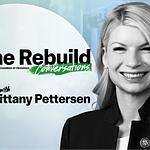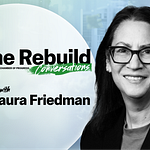In this episode of The Rebuild, hosts Tahra Hoops and Gary Winslett sit down with Aaron Shroyer, former Special Assistant to President Biden for Housing Policy on the White House National Economic Council. Shroyer shares insights from his journey through city government, the Urban Institute, HUD, and the White House — revealing how local, research, and federal perspectives shape better housing policy.
The conversation dives deep into the future of housing affordability, from reforming NEPA (National Environmental Policy Act) and unlocking modular construction, to rethinking how federal, state, and local governments can build smarter, faster, and fairer. Shroyer also discusses his recent work with the Searchlight Institute and a forthcoming paper from Brookings, tackling urgent housing supply and infrastructure challenges ahead of the 2030 census.
Whether you’re a housing policy wonk, a YIMBY advocate, or just curious about how Washington can help (or hinder) new construction, tune in to hear an unfiltered look at the policies, politics, and practicalities of fixing America’s housing crisis.
Tahra Hoops: Hi everyone. Welcome to the Rebuild. I’m one of your hosts, Tahra Hoops, alongside Gary Winslett, and today we are joined by Aaron Shroyer, who most recently served as special assistant to President Biden for housing policy, the White House National Economic Council. That’s a mouthful earlier in the Biden administration.
He also worked as a senior advisor at HUD and a policy advisor at the White House Domestic Policy Council. Before his time in the federal government, Aaron worked at the Urban Institute and for the city of Kansas City, Missouri. Aaron, thanks for being here.
Aaron Shroyer: Thank you.
Tahra Hoops: So you’ve had a fascinating career path in the housing policy world from working on housing and economic development in Kansas City to advising on housing research at the national level, and then also serving in the White House on various initiatives.
How have those varied experiences at the city think tank and federal level shaped the way that you approach housing issues? Are there any lessons or perspectives from your time here that you found especially valuable in crafting policy at the national level?
Aaron Shroyer: Sure. Well, first of all, I’d like to just thank, thank you both for ha, for having me on. Uh, and I’ll say that your new newsletter has quickly become one of my, uh, go-to reads in, in the morning. So thanks for all for all the work that you’re doing there.
Tahra Hoops: We love that.
Aaron Shroyer: And Gary, I especially liked your Scrooge McDuck mention from a few weeks ago, so we’ll have to find some way to work that into the conversations. Tahra, as you said, really those past experiences influenced how I approached my job in government at the White House. So my time at Urban exposed me to a lot of people ideas. It was really really helpful once I got into government to have relationships with those folks. Whether at the eviction lab or Zillow or a Federal Reserve Bank, or other places that I worked with while at Urban. One of the biggest challenges that we had in the early days of the admin is that we had really incomplete information from the ECS and census sources. So we were trying to make choices about the eviction, moratorium, emergency parental assistance and things like that, and getting the insight and just, having that ability to tap into the network that I had, from Urban was super helpful.
And then, going back to my local experience, that gave me a real perspective on how so much of the federal funding that we put out lands in place. As both of you know, much of the federal funds are passed through to local governments. So it’s super important to design programs with the end user being the local government in mind. A good example of that was the state and local funds from the rescue plan, which were block grants, but they didn’t include the typical strings that you see from a federal program. And I think it is no surprise jurisdictions found those much easier to use than, let’s say, a typical HUD block grant. Just to bring that to the present day, what I’m doing now is writing about the ideas that were things I had hoped to do if I got the chance to stick around at the White House, but that I think are nonetheless important to get out in the world.
And I’m excited to talk about some of them with you all.
Gary Winslett: I wanted to ask you about that, Aaron. You were just talking about how the local governments like these grants that don’t have 84 strings attached to them, right? I think Ezra Klein had the most famous metaphor here, which was the everything bagel. I kind of prefer this metaphor of nine birds, one stone.
Like you’re trying to hit nine birds with one stone and like if you try to do that, you just don’t hit anything. So I’m just curious, what are some of your thoughts on ways in which we can help policy makers focus and prioritize in terms of housing policy instead of treating housing policy like a thing that should also accomplish 18 other policy priorities?
Aaron Shroyer: I think that it’s super important to, as you said, make sure that the programs that have a core purpose to build more housing are doing so. That seems obvious, but I think sometimes that gets lost. So one of the first papers that I put out followed the Abundance book, which I think was a great framework to think about these issues and it, um my paper focused on NEPA [National Environmental Policy Act] reform. So essentially if there’s new housing or renovation that’s funded with federal funds, with HUD funds, in most cases before the parcel can be purchased, before a building can be built, the entity that’s sponsoring the has to go through a NEPA review and it seems nonsensical in a bunch of circumstances where it’s going to support infill development and building in exactly the sorts of places that we want to build. So I think that’s just one good example of how the government can really get out of its own way to focus more on the outcomes that we want to see and not the process to get there.
Gary Winslett: I think that’s totally right. Something else I wanted to ask you about is, one of the things that happened during the Biden administration out in the market is that we got these really cool technological developments around modular construction, around offsite construction.
Mass timber is a good example, but it’s not the only one. I would just be curious what your thoughts are on what the federal government or state governments can do to accelerate the rollout of these new kinds of building technologies?
Aaron Shroyer: Sure. So I think it helps to just kind of put some numbers behind it. Right now, each year we build somewhere in the range of 1.3, 1.5 million in new units. Of that, roughly a million are single family homes and then the rest are multifamily. Of that combined total, less than 10% of those units are built with offsite construction. So if we’re going to dig ourselves out of this supply shortage in let’s say five years, we would need to build something like 2 million homes each year for several years, which would be an increase of 33% over the baseline that we’re at right now. And given the construction worker crunch that we’re seeing, it’s reasonable to say that if we are going to dig ourselves out of that shortage, then techniques like offsite construction are gonna be a bigger piece of the puzzle than they are now
Gary Winslett: Mm-hmm.
Aaron Shroyer: They are more efficient in the workers that they take to build a given type of housing.
Gary Winslett: Yep.
Aaron Shroyer: But it’s risky to invest in the factories to build that housing. There’s a lot of upfront investment and the demand for the housing produced is uncertain. So one of the ideas that’s out there is for local and state governments to invest more of their own money or passthrough funds in actually constructing those factories. And then trying to figure out some way, knowing the production schedule that’s out there through LIHTC [Low-Income Housing Tax Credit] or production subsidies or financing, figure out some way to purchase the demand for those factories as a way to de-risk those investments.
Gary Winslett: Smart. I like the model of doing the purchase agreement to get the investment to be de-risked. I mean, it’s basically what we do in pharmaceuticals a lot, right? Like the government will guarantee we will bulk purchase all this stuff. And so then that makes it, obviously, a better investment for the business.
Tahra Hoops: A lot of this kind of brings me back to your recent paper that you have out with the Searchlight Institute on Winning the Census, and I was so excited to see this paper come out because it really does have the political framing and urgency that we need right now to understand why the housing undersupply is such an issue.
Because one, we should be building more houses on merit alone. Everyone should have a place to live, and housing costs are going up, but we’re not really focusing on the political ramifications of this. For example, your paper starts off with mentioning how over 1 million residents have left California in just four years alone.
And obviously a lot of that started during the COVID Pandemic, but high housing costs was one of the main factors that they cited for why they left and they went over to red states like Texas, or you have people fleeing New York and they’re going down to Florida. It’s something Republican governors are even bragging about.
So how should policy-makers respond to these kinds of affordability driven migration trends? Do you see this to be kind of like a state by state competition? Do you think it’s going to be a more coordinated national solution? I myself am more pessimistic on that side, and that’s why I like that your paper focused on governors in the near future solving this issue instead.
Aaron Shroyer: Yeah, so I think first it is important to mention the LIHTC investments that are in the OBBBA [One Big Beautiful Bill] or whatever we’re calling that bill these days. And so those will add up to essentially one extra year’s worth of units produced over the next decade. So while I think that there’s much more that the Federal government should do, getting that investment is a big deal, but also it’s not sufficient on its own and I think that’s where states come in. And I think that there’s been a lot written on how Democrats are looking forward with current trends they can’t rely on what’s called the blue wall to win the presidency beyond 2028, given the trends and the likelihood of the places that are gonna gain and lose electoral votes. So I hope that governors realize that if they want to retain and to attract residents before the 2030 census that they need to take action... well, really yesterday, but they need to take action now because decisions that they make and laws that they pass in the next year translate to shovels in the ground in 2027 and 2028, and residents who move in in 2029, 2030. So with that piece at Searchlight, I was trying to convey the urgency and with that I hope that there’s a friendly competition between governors to see how much they can do on their own and with their legislatures to build housing because I think besides LIHTC Reform, they’re not gonna get much help from the from the Trump Administration. I think they’re only gonna face headwinds from the Trump Administration.
Tahra Hoops: Mm-hmm.
Gary Winslett: I would love to see that be the format of competition between red and blue states. Who can out-YIMBY the other one? Like who can actually do better at delivering affordability for residents? I would love that to be the field the two parties are competing on.
Aaron Shroyer: I think with that piece that I put out, as you saw, you know there are a lot of states doing a thing or two things.
Tahra Hoops: Mm-hmm.
Aaron Shroyer: My piece focused mostly on what governors can do on their own. There’s been good executive orders that have touched on certain facets, but I think that the oomph behind the piece was saying that it’s not enough to do one thing, we have to do all of the things and do them now.
Gary Winslett: Yeah. You had mentioned shovels in the ground and spending based on the census. I wanna ask you about infrastructure, because we’ve seen the federal government laws, the various initiatives to help cities add housing around new transit lines. And that’s important, right?
At least in my view, if you don’t get the transit right, that really adds fuel to a lot of NIMBYism. If people are terrified that they’re gonna lose their parking or traffic’s gonna get so much worse then it turns a lot of otherwise not YIMBY people a little skeptical of housing. And so you gotta get the infrastructure and the transit right.
So how do you think we can better integrate housing policy with infrastructure and transit planning? Do you think we need new policy tools or is there some other mechanism of getting these two to work together a little better?
Aaron Shroyer: Sure. I think first, as you said, it needs to be legal to build more housing near transit, and it is not in a lot of places and reforms like [California’s] SB79 that just passed are great steps forward. So we should recognize that. But I think that a big theme of my work is tha beyond the zoning reform to make it legal, that there’s more that we need to do to ensure that buildings get built.
And so there’s a twp programs at DOT [Department of Transportation] TIFIA [Transportation Infrastructure Finance and Innovation Act] and RRIF [Railroad Rehabilitation and Improvement Financing] that provide below market rates for loans to residential projects, near transit stops. These were a big focus of my time at the White House— trying to figure out how we could make them work because to date they have not closed a residential loan because these programs essentially weren’t set to do so. They were set up for things like toll roads. So if you look at the process to get loans approved, they sort of mirror what that process looks like.
You need things like investment-grade credit, credit ratings and things that are just not part of the underwriting process for housing. Then in recent years there have been different bills that expanded what those loans could go towards that include residential, but they didn’t change what you need to do to get a loan. So there’s a mismatch there.
Tahra Hoops: Gosh…
Aaron Shroyer: And so a bunch of my work at the White House was working with DOT to do all that we could without changing the statute to make it so that we could potentially close loans, really make the program work. It has potentially tens of billions in loan authority that it can do. You really need Congress to make some changes. So with that in mind I have a paper that’s gonna come out tomorrow at Brookings.
Tahra Hoops: I was going to say, I want to hear more about this. I feel like this should have been its own chapter in the Abundance book. This is just an insane thing to hear.
Aaron Shroyer: So we have this surface transportation re-auth that needs to pass a year from now, essentially. Now is a great moment to get the ideas out there for how to make funding sources like these work better. And I know that a bunch of that work is ongoing by various think tanks and friends of ours in DC.
So the hope is that the ideas in this paper to make it so that this program is actually better set up to make residential loans can encourage the construction of homes near transit. And then I think that the second thing, to your question of how to coordinate these investments better.
I think, Gary, you’re going to appreciate this being in Vermont, is that there’s a lot of projects that don’t occur because the potential parcels that they’re on are not linked up with water and sewer and that the jurisdictions put the cost of doing that on the developers make it so that those deals…
Gary Winslett: Yes. I’ve even seen towns in Vermont turn down free water and sewer investment from the state because they don’t want new housing near them. Under this like totally bananas idea of like… it’s like the reverse Field of Dreams. You know that movie? It’s like if you build it, they will come.
Well there’s this super NIMBY idea of like, well, if we don’t build it, maybe they won’t come. It’s just crazy to watch water and sewer be intentionally turned down for the purposes of no new housing.
Aaron Shroyer: if we don’t build it, they won’t come and our existing residents will get priced out. That’s a horror film, not a field of dreams type of movie.
Gary Winslett: Yeah.
Tahra Hoops: I mean I’m just hearing all of this and I’m just like, these are very niche, wonky issues that hold up so much housing development. But unless you yourself are in the weeds, the average person is like not going to hear this, and then they’re just going to be like Scrooge McDuck, they’re going to go find a random villain and blame it on it.
It’s like, no, it’s so much more. Okay, wait for anyone who has not read the Scrooge [post], Gary, can you please give us an overview of your piece?
Gary Winslett: Sure. The piece is just arguing that some Democrats have this really bad habit on cost of living issues, where they always wanna find some Scrooge McDuck somewhere to blame the high costs on when actually it’s usually a supply problem. But that doesn’t feel as emotionally powerful as blaming some sort of greedy rich person somewhere like a Scrooge McDuck swimming in the coins.
Rich people don’t have class solidarity, like the rich developer is getting rich by building housing, whereas like the rich NIMBY is protecting their views because they just like the
Tahra Hoops: Property values.
Gary Winslett: Right, or property values they just don’t like change. There’s not a class solidarity between them. And so it’s like an analytic mistake to approach a lot of these cost of living policy challenges from a position of find somebody to blame versus a position of, well, how do we build more so that everybody has part of the good life.
Tahra Hoops: Aaron, in your line of work, have you seen opposition similar to what Gary is describing pop up, have you seen any direct opposition from the initiatives that we worked on that has kinda taken you aback.
Aaron Shroyer: Yeah, so I think that you see this within the polling that’s done in this space.
Tahra Hoops: Mm-hmm.
Aaron Shroyer: I’m not sure if this is specific to housing, but when you ask people what they think is to blame for high prices or sort of who to blame? The econ 101 of supply and demand is not very high in their mind.
It is the corporate landlords or other things like that. Those make for effective villains, potentially, to Gary’s point. But I think that they’re more the symptom of the problem than the cause. And I think that they’re… I’m not sure if you’ve seen this series on TikTok that, Chi Ossé does in New York City
Tahra Hoops: Yeah.
Aaron Shroyer: He has this great framing where he is like, the best way that we can stick it to the landlords is to build more so they don’t have more profit. And I think that there’s more that needs to be done with the messaging to convey that and make the economics for people, or the rationale for people resonate in a way that I just don’t think it does now.
Tahra Hoops: I love that you brought up Chi Ossé because I love the work that he does, even if sometimes I think some of his policies are a bit to the left of mine. I appreciate what he is doing in order to explain to his constituents why he’s spending so much time on a wonky bill that people might at face value… like you agree, would not even kind of agree with him on, and it’s something that I..
I think Democrats are complete losers right now. And when you are the losers you should be focused on coalition building. So if the polling is telling us that voters are not understanding why housing is so expensive and they are retreating back to an emotionally charged response, that means we need to be better at persuasion and messaging on why these policies are actually going to re achieve the progressive values that we all want.
It’s pretty progressive to want landlords to have more competition, like you are fully sticking it to the man by having so much housing out there. Landlords are gonna be like, well, I have to lower my rent in order to catch up with everything.
It’s the same thing in New York City and how they have so many bodegas everywhere. They’re all so cheap because they know they have to compete…
Aaron Shroyer: Yeah, and this is more of a question for potentially the listeners, but one of the things that I think has not really been a focus of the YIMBY or the abundance movement for housing is, you know, let’s just say you’re a mayor or a governor who runs on a pro supply to lower cost platform and you make some changes within your first year to make it easier to build, to unlock supply. It’s likely based on how long it takes to build that supply, that the impact from that won’t be felt until the end of your first term, if you have a four year term.
So I think that it is important and you’ve seen more folks talk about this and sort of get credit for being caught trying. But I do think that there is more that these electeds are gonna need to do to deliver for people in the short run to lower costs and to do so in such a way that is not, you know, rent control, for instance, that could undermine their core mission to boost the supply.
So I don’t quite know what the perfect complement of those short term wins and ways to fight is, but I think it’s a really important thing for electeds to figure out, not just how to message, but also how to produce for people for these longer term supply boosts can take hold.
Tahra Hoops: I think... Especially at the state level, people have to be okay with smaller bills being passed at times. I remember there was this very small housing bill a couple of months ago, and forgive me because I cannot remember the exact name of it, it mainly was increasing the amount that people could take out pre-tax in order to go buy their first home.
And someone posted about it online. I said, this is great stuff. Moving on. It’s like, this is not gonna do much to solve the affordability crisis. I was like, not all bills are going to be one stop shots to solve the affordability crisis. Sometimes you have bills because you need to work in the system that you have and your constituents need relief now.
Like that is just the way the world works. And we should applaud elected leaders for operating in the sense that they can.
Gary Winslett: Right. I totally agree. Like I grew up playing football, so I always think of it on a football framework of like, if it’s third and four, a five yard gain is good. Like you got a first down. You don’t have to score a touchdown with every play, and it’s bad to adopt a mentality of, well, if it isn’t a touchdown this play what were you doing? Well, it’s like, no, no, no. You march forward over time and like that’s how you get incremental wins that stack up.
Aaron Shroyer: Yeah. And, and I think to that point, you know, if it took us a decade plus to get into this mess, it’s gonna take us... I hope not that long, but it’s gonna take time and we’re gonna have to hit singles or, you know, gain four yards. To your point, Gary, you know, there is no one simple fix to solve housing...
Gary Winslett: Right.
Aaron Shroyer: What’s exciting about the space right now is that I think there’s energy behind it. There’s a lot of people trying new things, and I think what’s gonna be important for the movement in the next few years is to get a better sense of what works and where, and then do more of that.
Gary Winslett: Yeah. No, I totally agree. I mean, that was why when we had our big report last year, we focused on a bunch of success stories. You know… Buffalo removes parking minimums, they get a thousand new units of housing over the next couple years, two thirds of which would’ve been illegal under the old parking minimums...
So just like a bunch of these like positive examples, I think could actually be really helpful for helping people see that actually these supply side policy reforms really do work.
Tahra Hoops: It’s showing that we need to go back to being the party that focuses on results and goals being achieved, instead of just having a lot of rhetoric saying like, maybe we can do this one day if we try really hard. Like it’s just, it’s going to fail, like it’s going to fall deaf on voters’ ears.
Rapid-Fire
Tahra Hoops: But in the essence of time we’re gonna wrap up here with some rapid response questions.
What is something that you think is too expensive and don’t say housing.
Aaron Shroyer: Oh, well, I was gonna say rent.
Tahra Hoops: Yeah.
Aaron Shroyer: If I can’t say housing, I’ll say food.
Tahra Hoops: Okay. That, I mean, that is always a good one. Tariffs are increasing the price of that by the day, so Thank you Trump.
Okay. Next one is: what’s an innovation or a recent advancement that you believe is just kind of overweight, like people are overestimating it.
Aaron Shroyer: All right. This may be a potential hot take late in the podcast, but I think zoning reform without some financing reform to accompany it. And what I mean by that, and I kind of touched on this before, is just because something is legal to build, doesn’t mean that it gets built and given how long it takes to build something, it’s in the interest of the officials that are passing zoning reforms to make sure that the reforms that they enact turn to units built.
So I think it is at times, and especially in where the demand isn’t crazy, it is insufficient to just pass zoning reform and, you know, wipe your hands of that. I think that there needs to be more done to pair that with tax abatements, with building on public land and other things like that.
Tahra Hoops: I love that. I feel like the YIMBY movement is hitting like a turn where we are all finally agreeing for the most part, outside for a couple of outliers that yes, zoning reform needs to happen, needs to be done, but financing is the next bucket that we need to be focusing on. And shout out to CPE [Center for Public Enterprise], I saw you did your infill paper with them.
They are starting an affordable housing series and a focus on financing. I will be attending tomorrow. I’m very excited about it. And it’s to give one-on-one intro to policymakers, other people in this sphere to understand how large of a part the financing part is because of their work that they’ve had directly with developers.
So I’m glad that’s becoming an emerging conversation because I agree we haven’t spent much time doing so, and I’m happy to sharpen my senses and knowledge on this issue as well.
Gary Winslett: All right. What is a policy or innovation that you think is underrated?
Aaron Shroyer: So I am gonna tease something that I am working on now. I’ve got a report that’s focused on the potential for housing on USPS owned land. And that’s also potentially because it is exempt from local zoning. And those parcels tend to be located, back to your question before, Gary, in the sorts of places where we wanna build more. So I think that there is potential there to build on USPS land to generate revenue for a postal service that needs it desperately. I may have to come back on the podcast once that comes out to talk through it.
Tahra Hoops: Yeah.
Gary Winslett: Mm-hmm, that would be great. I would love to hear more about this ‘cause I know that that had gotten floated and discussed with an EO in the Biden administration, but it sort of needed more than that to get going. So I would love to hear more about that at some point.
Aaron Shroyer: Stay tuned.
Gary Winslett: Will do. Last question. We’d like to know if you have any sort of… off the wall policy ideas that you favor.
So I would be a big fan of having sort of a federal moratorium on localities subsidizing sports stadiums because the economics of it are terrible. It’s awful for taxpayers, but localities feel like they’re hamstrung because if they don’t say yes, the team will leave for somewhere else. Like that stinks for everybody. Whereas if the federal government just said, nope, you’re not allowed to do that, that would actually be tying the hands of the localities in ways the localities would actually really like. So I’m just curious if you have any of these other sort of unorthodox ideas.
Tahra Hoops: We won’t hold you to them. Don’t worry.
Aaron Shroyer: I am gonna be boring and just stick with what I know for housing and say... One idea that’s a bit off the wall would be to require places to hit production thresholds in order to make their residents eligible for SALT [state and local tax] deductions.
Gary Winslett: I like this. I like this a lot.
Aaron Shroyer: So saying, sure, you can deduct state and local taxes, but only if you build sufficiently and just... I don’t think it would ever stand a chance of getting passed, but like what that would do to the NIMBY folks that own their homes in jurisdictions would be fascinating.
Tahra Hoops: You have at least two supporters here on that if it ever goes somewhere.
Aaron Shroyer: Great. Okay. Well, we can build that movement.
Tahra Hoops: Love that. Okay. Well thank you so much for being here. We’ve really enjoyed this
Gary Winslett: Yeah, this is fun.
Tahra Hoops: It’s been great and hopefully we’ll see you soon when you come out with that new paper. That will be out by the time this episode is out. You said it’s going to be in the Brookings Institute?
Aaron Shroyer: That’s right. Yep.
Tahra Hoops: Amazing. We can’t wait to read it. Thank you.
Aaron Shroyer: Thank you.
Gary Winslett: Thanks, Aaron.











